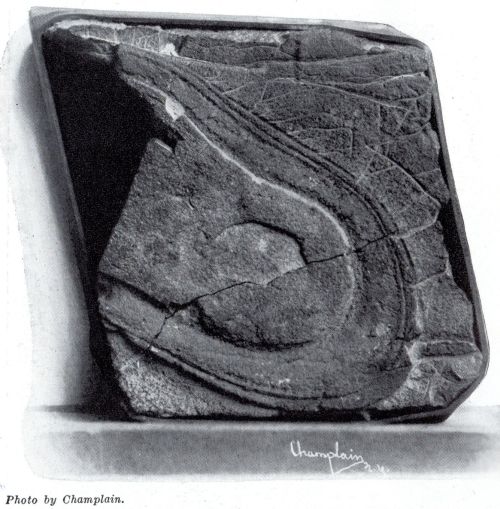
God--Or Gorilla McCann, 1925).
Click on image for large view

|
Fig. 1a. Alleged Nevada shoe print from | God--Or Gorilla McCann, 1925). Click on image for large view
|
|
Part of Kuban's Paluxy web site
A number of strict creationists and "ancient anomaly" enthusiasts have claimed that a "shoe print" was found in Triassic rock near Fisher Canyon, Pershing County, Nevada. (Brenner, 2006; Cremo and Thompson, 1993; Jochmans, 1979; Tanner, 1975; von Fange, 1981; Wenlong, 2006). Although most of these authors state that the print was found by John Reid in 1922 (or 1927 according to some), evidently it was actually found by Albert E. Knapp, an employee of Nevada Mining Company, on or before January 15th, 1917 (Hubbard, 1927).
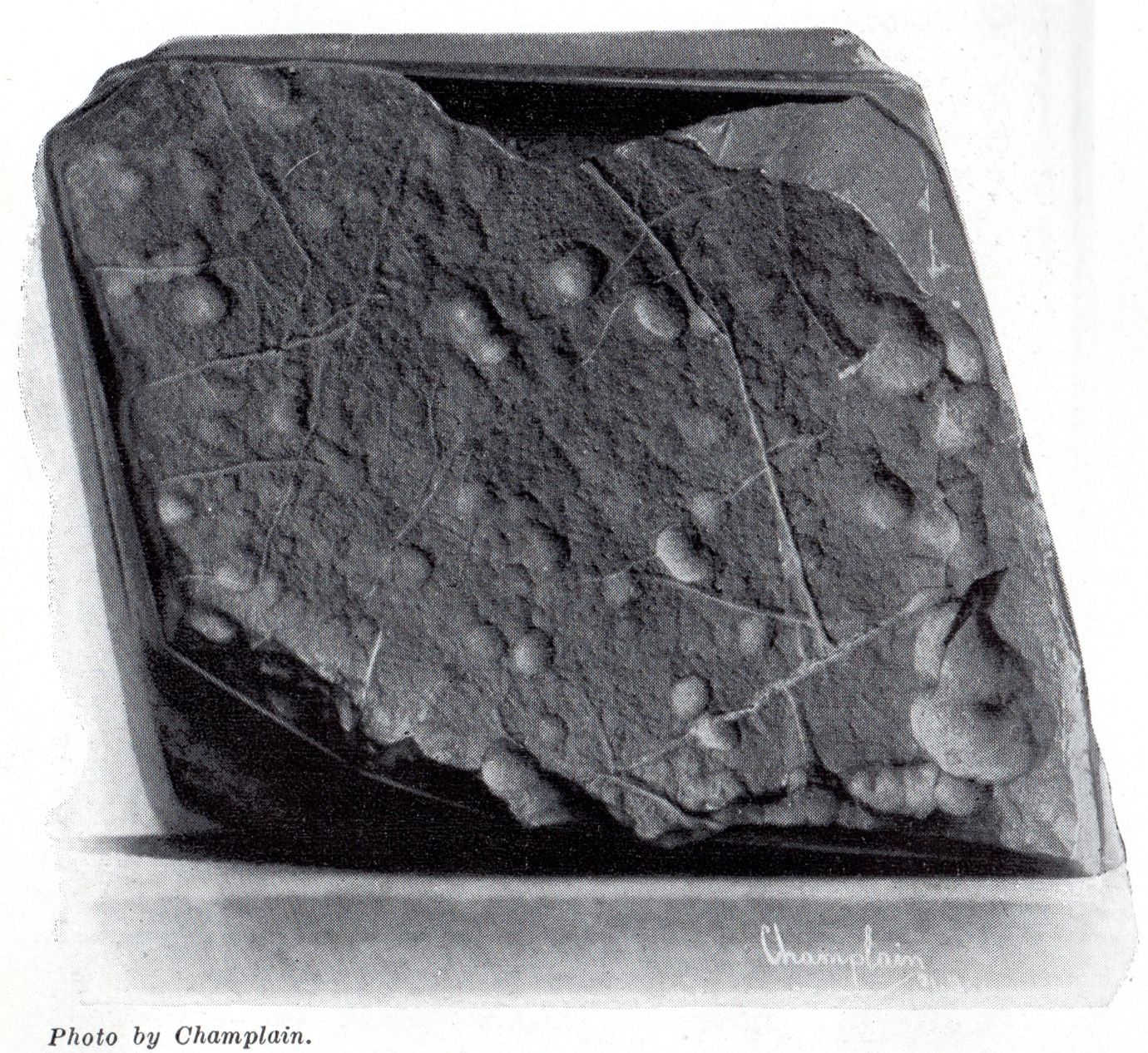
|
|
Fig. 1b. Opposite side of alleged shoe print, from God--Or Gorilla McCann, 1925). |
"Some time ago, while he was prospecting for fossils
in Nevada, John T. Reid, a distinguished mining engineer and geologist,
stopped suddenly and looked down in utter bewilderment and amazement at
a rock near his feet. For there, a part of the rock itself, was what
seemed to be a human footprint! Closer inspection showed that it was
not a mark of a naked foot, but was, apparently, a shoe sole which had
been turned into stone. The forepart was missing. But there was the
outline of at least two-thirds of it, and around this outline ran a
well-defined sewn thread which had, it appeared, attached the welt to
the sole. Further on was another line of sewing, and in the center,
where the foot would have rested had the object really been a shoe sole,
there was an indentation, exactly such as would have been made by the
bone of the heel rubbing upon and wearing down the material of which the
sole had been made. Thus was found a fossil which is the foremost mystery
of science today. For the rock in which it was found is at least 5 million
years old."(Ballou, 1922).
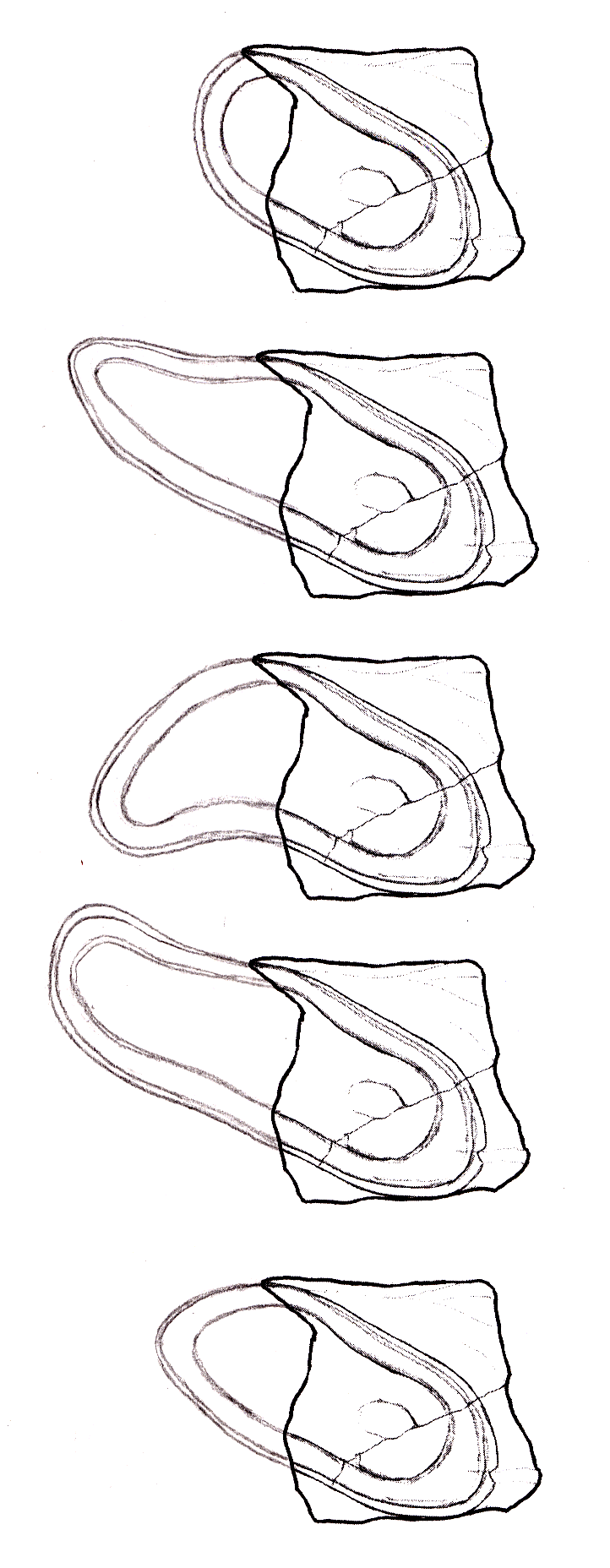
Fig. 2. Some of the many possible shapes the missing
portion of the concretion might have taken
Ballou's account not only starts by mistakenly crediting Reid rather than Knapp as the discoverer, it also ends with a somewhat misleading comment about the rock's age. If the print was found in Triassic rock as most of its proponents assert, then the mainstream age would be at least 200 million years (while many strict creationists would hold that it is no more than 10 thousand years old).
Aside from those issues, There are a number of more serious problems with the shoe print interpretation, even without getting into the abundant evidence against YECism. The first is that from the available photographs (Figs. 1a, 1b), the object appears to be a broken ironstone concretion, perhaps one that has suffered some erosion. Such concretions often show ovoid shapes and concentric banding similar to the Nevada "shoe print." As noted on the website, amonline.net, "odd shapes of concretions arouse curiosity and they can often be mistaken for fossils, bones, meteorites or other unusual objects. Concretions can have regular shapes like blocks, boxes, pipes, flat discs, canon balls, or even resemble parts of a human body such as a foot or rib." Likewise Rowe et.al. (2001) state (when discussing an alleged dinosaur heart), "Ironstone concretions are notorious for producing suggestive and misleading shapes."
Ballou states that the print shows about half of its original shape, and McCann (1922) claims the print would fit a child's number 13 shoe. However, both comments involve considerable presumption about the missing portion. In reality, one cannot know the precise length or shape of the missing section (see Fig. 2). Even if the original specimen had a shape compatible with a normal shoe (basically an elongate oval), such a shape is not uncommon for inorganic features, especially concretions. Therefore, unless one found a series of such markings in a repeating left-right sequence, there is no basis for interpreting them as human prints.
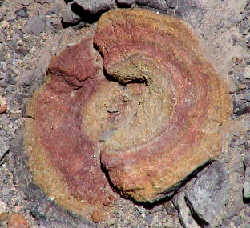
|
| Fig. 3. An ironstone concretion |
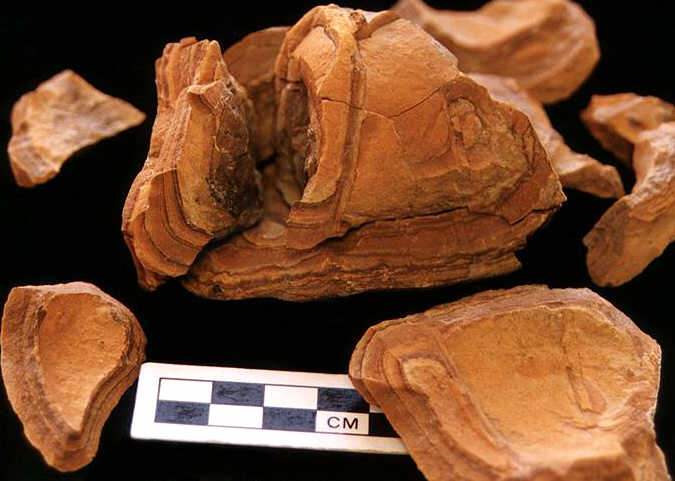
|
| Fig. 4. Some iron-stone concretions showing concentric banding |
Similar banding is also common in sandstone slabs. Such features are called "liesegang rings" for their similarity to tree rings (Fig. 5a). Geologist Andrew MacRae explains that such stones are typically orange, red, or brown in color, since they are rich in iron oxides. He notes that they form when oxygen-bearing water diffuses through a porous rock, often from fracture surfaces, and that the process often leaves concentric rings of alternating color, "...not unlike rings of a bathtub, except the process occurs in three dimensions." (MacRae, 2006).
McCann (1925) includes a photo of what he calls the "underside" of the slab (Fig 1b), with the caption stating, "Note impressions left by early life forms from the Triassic seas." Evidently he is referring to the many little bowl-shapped depressions in the slab. However, their origin is not clear. If indeed they are made by "early life forms" from an ancient sea, it would seem to create additional problems for his shoe print interpretation. Nor has he established that they are on the bottom of the slab, rather than the top. Indeed, the latter seems more likely, since such depressions are fairly common on rocks representing Paleozoic sea-bed surfaces.
In 2005 I stopped at a landscaping and building-stone supply yard near Houston, and observed a number of such slabs, some of which showed ovoid and roughly footlike shapes (Fig. 5b). The banding extended beyond the footlike shapes, showed no appreciable topographic relief, and clearly were not real footprints. However, portions of such slabs might become more footprint-like with erosion--especially if only the center portion were preserved. These examples reinforce the point that finding merely an isolated oblong shape on rock (let alone a portion of one) is far from compelling evidence of a genuine footprint.
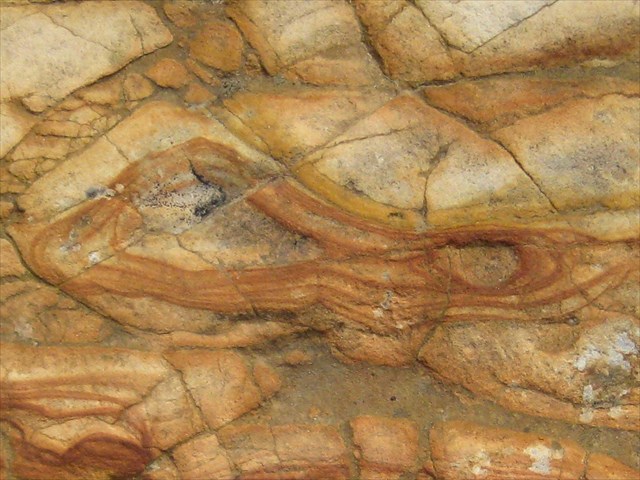
|
| Fig. 5a. Liesegang rings, Cape Town, S. Africa. |
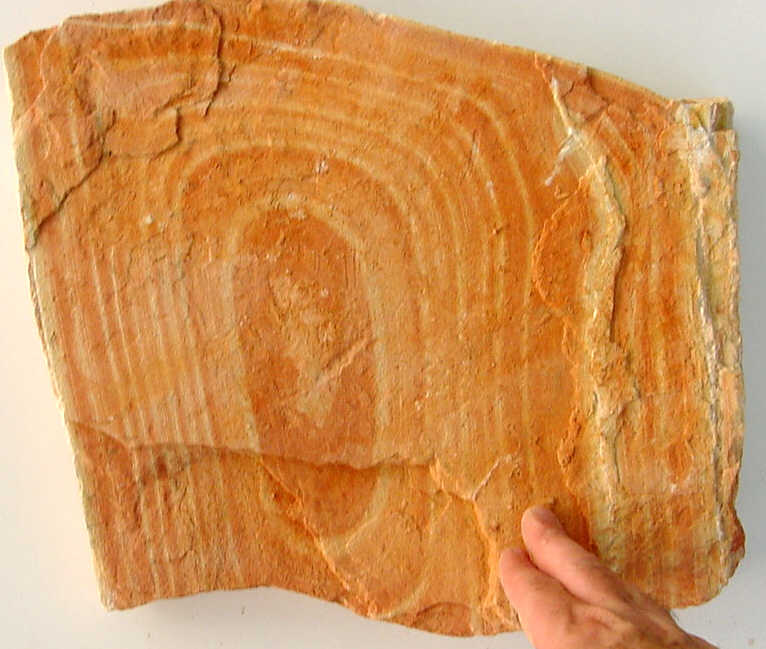
|
| Fig. 5b. Sandstone slab from building-stone yard |
McCann states that the Nevada print was found by Albert Knapp "on the North slide of Buffalo Peak, about twenty miles due easterly of the town of Lovelock." He also states that the rock formation there is Star Peak formation, and that the supposed shoe print shows "veinlets of calc-spar characteristic of the blue limestone of the Triassic stratum." The Star Peak is middle Triassic (Nichols and Silberling, 1977), which would make the rock approximately 235 million years old by conventional geology. However, evidently there has been no independent confirmation of the specimen's lithology or association with this formation, or evidence that the surface of the print is a bedding plane. Real prints always occur on bedding planes. Nor is there any evidence that the object was ever part of a striding sequence. Indeed, by most accounts the rock was found on a pile of loose rocks (explaining why the missing portion was not collected). The present whereabouts of the specimen are also unknown. Despite the problems with the shoe interpretation, and the fact that even most strict creationist groups do not endorse it, McCann and Tanner ridicule skeptical "evolutionists" as closed-minded.
Young-earth advocate Jeff Brenner (2006) stated on his website (removed in 2007), "The print was inspected by geologists and admitted that the print is authentic." However, the only geologist he mentioned by name is Ried, whom he mistakenly credited as the discoverer, and whose views are not even stated in any of the literature I have found on the topic. McCann (1925) does include the comments of three geologists, but they merely remarked on its resemblance to a shoe print, using terms such as "natural mimicry," "surprising imitation by nature," and "most deceptive"--indicating that they did not regard it as a real print. Brenner also repeated past claims about the stitching features with no supporting documentation. He suggested that the lack of "evolutionist" response to the "print" is evidence of its authenticity. However, besides myself, other mainstream workers have addressed this claim--as far as they can based on the sketchy evidence available (Fitzpatrick-Matthews, 2006) . Also, Brenner's reasoning was backwards. Whenever extraordinary claims are made, the obligation is on the claimants to provide the evidence to back them up, not on others to refute them, especially when poorly documented.
The "Nevada shoe print" claims are not well supported by the available evidence. The footprint advocates have presumed that the missing portion of the object was very shoe-like in shape, whereas any number of other shapes are possible. They have not demonstrated that the supposed print was ever part of a striding sequence, or that it contains the detailed "stitching" features they assert. The present location of the object is unknown, impeding further study. Judging from the available photographs, the specimen is most likely a broken ironstone concretion, perhaps one that has suffered some erosion.
Acknowlegements: I would like to thank Keith Fitzpatrick-Matthews for helpful comments and assistance in locating pertinent references.
Ballou, W. H. 1922, American Weekly section of the New York Sunday American (Oct. 8).
Brenner, Jeff. A. 2006, "The Nevada Track," Web article at: http://www.bennerwc.com/ancientman/02_nevada.html. Note: In 2007 Brenner's website was removed.
Cremo, Michael A. and Richard L. Thompson, Forbidden Archeology, Govardhan Hill, USA, 1993.
Hubbard, Samuel, 1927. Discoveries relating to Prehistoric Man by the Doheny Scientific Expedition in the Hava Supai Canyon, Northern Arizona, October and November, 1924. (Oakland: California Museum of Natural History), Sunset Press. (online at http://www.creationism.org/swift/DohenyExpedition/Doheny02Supplement.htm).
Fitzpatrick-Matthews, Keith J., 23, 2006, Fischer Canyon (Nevada) footprint, web article at: http://kjmatthews.users.btopenworld.com/cult_archaeology/out_of_place_artefacts_12.html
Jochmans, Joseph R., 1979, Strange Relics from the Depths of the Earth (booklet). Forgotten Ages Research Society, Lincoln, NE, p. 17.
MacRae, Andrew, "Fossil? Oddities" website at: http://www.geo.ucalgary.ca/~macrae/t_origins/carbbones/pfossils.html
McCann, Alfred W., God -or Gorilla, 1922, New York: Devin-Adair.
McCann, Alfred W., God -or Gorilla, 1925 (Fifth Printing), New York: Devin-Adair Company.
Nichols, K. M., and N. J. Silberling. 1977. Stratigraphy and depositional history of the Star Peak Group (Triassic) northwestern Nevada. Geological Society of America Special Paper, 178.
Rowe, Tim, McBride, Earle F., and Sereno, Paul C., Science, 2 February 2001: Vol. 291. no. 5505, p. 783
Tanner, Jerald, 1975, Views on Creation, Evolution, and Fossil Man, Modern Microfilm Company, Salt Lake, UT
Yancey, Tom , 2006 (email communication). Dr. Yancey is a professor in the department of geology and geophysics at Texas A & M University. He agrees that the object is likely a fractured concretion, and adds that the banding probably represents silica, with any porosity within in the bands due to incomplete replacement (Yancey, 2006). This might explain the supposed "stitching" features.
Von Fange, Eric A., 1981, Time Upside Down, Ann Arbor, MI., p. 33.
Yu Wenlong, Ed, 2006, web site article at: http://www.pureinsight.org/pi/index.php?news=2979